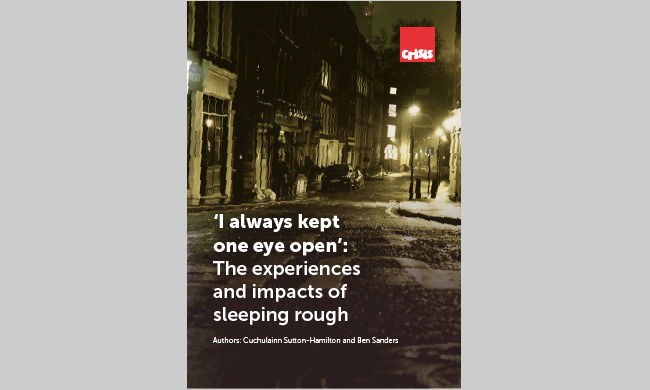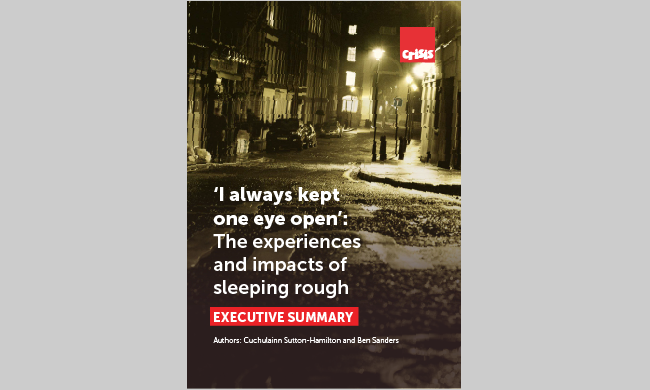‘‘I always kept one eye open": The experiences and impacts of sleeping rough
18.12.2023
Rough sleeping, the most visible form of homelessness, is increasing and shockingly more and more people have no choice but to sleep on our streets.
Crisis conducted research in late 2023 with 157 people who have slept rough within the last two years. Many participants were still sleeping rough. The survey was completed face-to-face across homelessness services in a number of locations in England including the North West, North East, Midlands and London. The survey was complemented by 20 in-depth interviews.
The research reveals the startling reality of life on the streets for people forced into sleeping rough. The report also details what needs to be done to prevent people having to sleep rough in the first place and how it can be ended for good.
Key findings:
- Overall, 9 out of 10 (141) people had experienced at least one form of violence, abuse or theft whilst sleeping rough.
- Shockingly, half (51%) of research participants experienced being physically attacked whilst sleeping rough. Sixty-one per cent had been threatened with violence or intimidated and 72% had been verbally abused or harassed. Over half of participants (53%) had things thrown at them including bricks and beer cans, with 83% of participants experiencing having items thrown at them over three times.
- These are not one-off incidents, either: more than 6 in 10 (66%) of those who had been physically attacked reported being attacked on more than three occasions; 83% had been threatened with violence and 92% had been verbally abused more than three times.
- Sleeping rough exposes people to the vagaries in behaviour of the general public, with 70% of the last 738 incidents reported by people in the research perpetrated by a member of the public. Of those participants who reported having been physically attacked, the perpetrator of the last incident was a member of the public in more than three quarters (76%) of cases.
- Sleeping rough greatly impacts on physical health, with 94% reporting at least one health issue, 78% reporting three or more health issues, and 39% having six or more. This shows just how damaging sleeping rough is on a person’s physical health. The main physical health issues experienced by 70% of participants were those caused by extreme weather conditions, living in physical pain (69%) and issues with feet and legs related to walking (66%).
- Of the 157 participants of this research, 86% had at least one or more mental health needs due to sleeping rough, 63% had three or more needs and 15% had six and over. This again shows that participants faced multiple and complex situations whilst sleeping rough. The most common mental health impacts reported by participants were Psychosis (experienced by 85% of participants), anxiety/ generalised anxiety disorders and depression (both experienced by 75% of participants). Just over half (56%) of participants said that they experienced suicidal thoughts, while 29% experienced post-traumatic stress disorder (PTSD).
- Homelessness increases the likelihood of someone experiencing loneliness: 62% (97) participants said that they often felt isolated from others, compared to approximately 6% of the general population reporting that they often or always feel lonely, suggesting that those sleeping rough are much more likely to feel isolated.
- Shockingly, 64% (101) participants felt that sleeping rough meant that they were afraid for their lives or that they might die. Sleeping rough can be deadly at worst, but will always be a trauma that can have a significant impact on a person’s life. This is highlighted by over half (56%) of participants feeling that sleeping rough has made it hard to live a ‘normal’ life again.
- In the short term the Westminster Government must remove the legislation from the Criminal Justice Bill that will criminalise people for being homeless, akin to the Vagrancy Act. Housing First needs to be scaled up so that it is available to all who need it. To address housing affordability in the short to medium term the level of investment in Local Housing Allowance rates must be maintained beyond 2024/25 and kept in line with inflation. Over the long term the Westminster Government should put in place a long-term plan capable of increasing the supply of social rent homes to meet current and future need – 90,000 social rented homes in England per year for the next 15 years.
Reference
Sutton-Hamilton, C., and Sanders, B. (2023) ‘I always kept one eye open’: The experiences and impacts of sleeping rough. London: Crisis.


